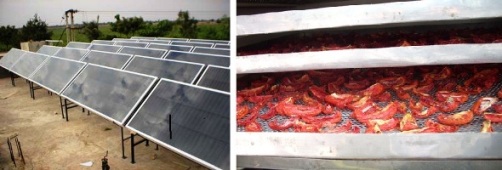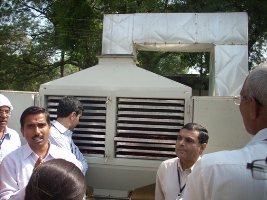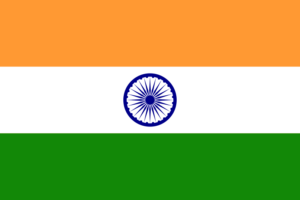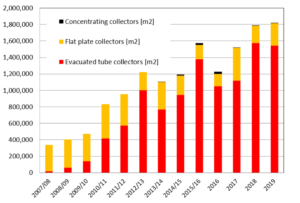India: Solar Air Drying gives a major Edge to Vegetable Farmers
June 8, 2010
 Solar air drying increases the competitiveness of India’s agricultural sector: For five years now, farmer Girishbhai Patel has been using a solar air dryer to accelerate the drying of tomatoes. The investment paid off in just four years.
Solar air drying increases the competitiveness of India’s agricultural sector: For five years now, farmer Girishbhai Patel has been using a solar air dryer to accelerate the drying of tomatoes. The investment paid off in just four years.
Photos: Malaviya Energy Consultancy
Five years ago, Girishbhai Patel, a farmer and owner of the company Shivam Solar Dryers, decided to speed up his business of drying tomatoes on a commission basis. To that purpose, the company from the city of Ahmedabad in Gujarat state, Western India, commissioned the Sardar Pate Renewable Energy Research Institute (SPRERI) to develop a solar air drying system. SPRERI has been at the forefront of developing a variety of solar air dryers for agricultural applications. The technical support with the design of dryers earned the scientists at SPRERI a major role in implementing this technology in the region (see http://www.solarthermalworld.org/node/1227).
The solar air heating system consists of a 60 m2 field of glazed air collectors with a total air flow rate of 3,000 m³/h. It can dry 125 kg of fresh tomatoes a day, from an initial moisture content of 95% to a final 10%. Before the drying chamber, the tomatoes are cut into 6 pieces by hand.
The temperature gain due to the solar energy amounts to between 25°C and 30°C. Since the air temperature required for drying tomatoes is at about 80°C, a solar air system as the only heating source would not have been enough. Instead, the company also integrated an automatic ignition system filled with liquefied petroleum gas LPG) into the drying chamber, which covers around 10% of the annual energy demand for the drying process.
Adjusting the air flow rate with the help of motorized dampers and timers in the top and bottom of the drying chamber further guaranteed a constant drying process. A timer-based control device was installed to operate the system in specified intervals.
On average, the system produces 8 kg of dried tomato per day, although its output can differ a lot between dry and rain seasons. According to Girishbhai Patel, the high quality of the dried tomatoes earned the company enough to recover the investment costs into the system in only four years. The difference between his company’s tomatoes and the ones dried under the open sun stems from the hygienic conditions and the colour of Patel’s vegetables. His system is one of the most successful case studies of solar thermal air drying for agricultural products in the country and could be an eye opener to other farmers.
More information:
http://www.spreri.org


